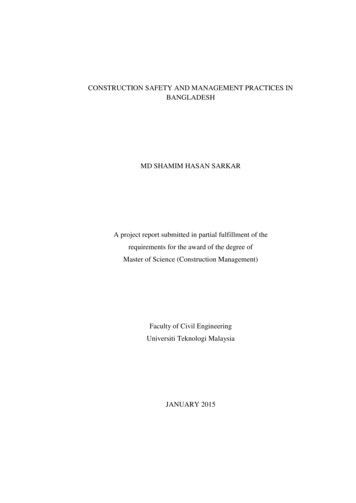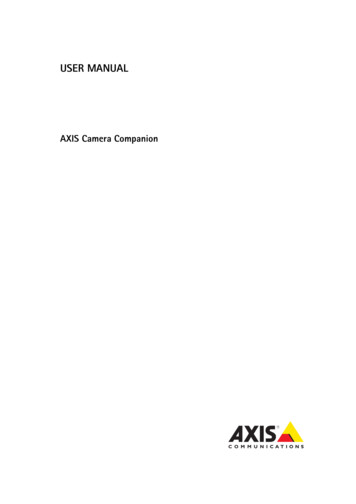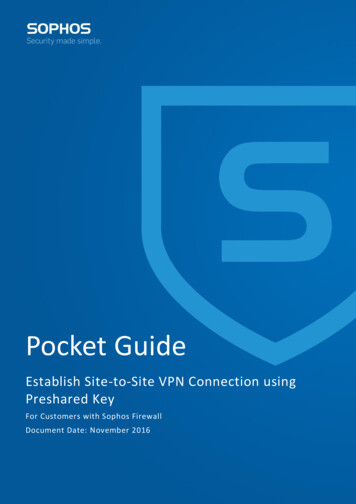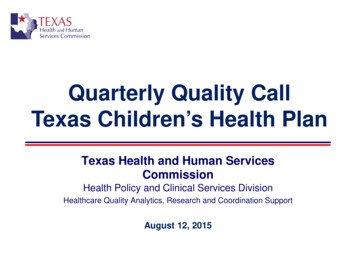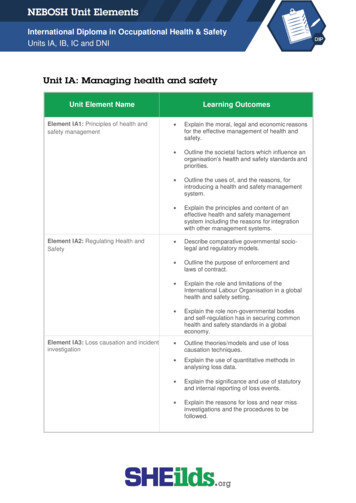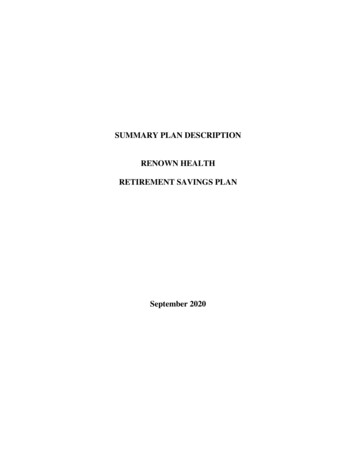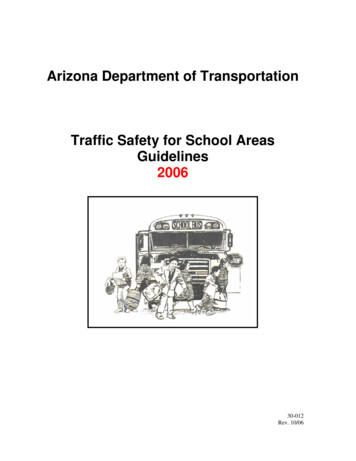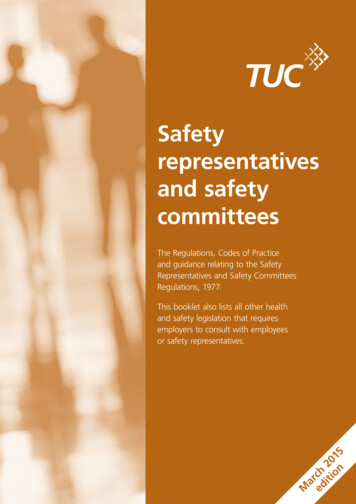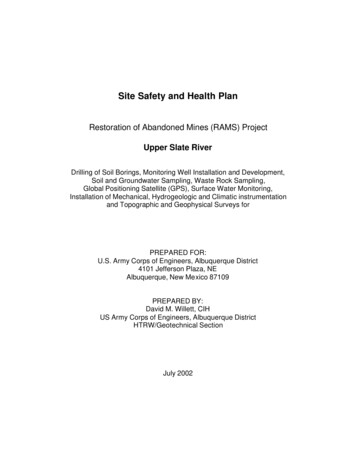
Transcription
Site Safety and Health PlanRestoration of Abandoned Mines (RAMS) ProjectUpper Slate RiverDrilling of Soil Borings, Monitoring Well Installation and Development,Soil and Groundwater Sampling, Waste Rock Sampling,Global Positioning Satellite (GPS), Surface Water Monitoring,Installation of Mechanical, Hydrogeologic and Climatic instrumentationand Topographic and Geophysical Surveys forPREPARED FOR:U.S. Army Corps of Engineers, Albuquerque District4101 Jefferson Plaza, NEAlbuquerque, New Mexico 87109PREPARED BY:David M. Willett, CIHUS Army Corps of Engineers, Albuquerque DistrictHTRW/Geotechnical SectionJuly 2002
Site Safety and Health Plan DisclaimerThe following Site Safety and Health Plan (SSHP) has been designed for the me thods presentlycontemplated by the Army Corps of Engineers, Albuquerque District for execution of theproposed work. Therefore, the SSHP may not be appropriate if the work is not performed by orusing the methods presently contemplated. In addition, as the work is performed, conditionsdifferent from those anticipated may be encountered and the SSHP may have to be modified.i
Table of Contents1.02.03.04.0Introduction.1-11.1 Objective .1-11.2 References.1-1Responsibilities.2-12.1 All Personnel.2-12.2 Health and Safety Manager .2-12.3 Project Manager .2-12.4 Site Supervisor .2-12.5 Site Health and Safety Officer .2-22.6 Subcontractors .2-22.7 On-Site Personnel and Visitors .2-2Project Hazards and Control Procedures .3-13.1 Scope of Work .3-13.1.1 General Overview .3-13.1.2 Supporting Tasks .3-13.1.3 Job Hazard Assessment .3-23.2 Field Activities, Hazards, Control Procedures.3-23.2.1 Mobilization/Site Preparation/Demobilization.3-23.2.2 Decontamination Activities .3-33.2.3 Drilling Activities .3-33.2.4 Soil/Groundwater/Surface Sampling Activities/Hazards.3-93.2.5 Well Development Activities/Hazards.3-103.2.6 Geophysical, Global Positioning Satellite (GPS) and topographicsurvey activities/Hazards .3-103.2.7 Installation of Mechanical, hydrogeologic, and climaticinstrumentation.3-113.2.8 Demobilization.3-113.3 Chemical Hazards .3-11Hazards and Control Procedures .4-14.1 General Practices .4-14.1.1 Buddy System .4-24.2 Sunburn/Ultraviolet Exposure .4-24.2.1 Sunburn/Ultraviolet Exposure Prevention.4-34.3 Heat Stress .4-3ii
5.06.07.04.3.1 Heat Stress Prevention.4-44.4 Cold Stress .4-54.4.1 Cold Stress Prevention.4-54.5 High Altitude stress.4-64.6 Biological Hazards .4-64.6.1 Venomous Snakes and Arthropods .4-74.6.2 Pathogens .4-94.7 Noise.4-114.7.1 Hearing Conservation .4-114.8 Spill Control Plan .4-114.9 Lockout/Tagout Procedures .4-114.10 Sanitation.4-124.10.1 Break Area .4-124.10.2 Potable Water .4-124.10.3 Sanitary Facilities.4-124.10.4 Lavatory.4-124.10.5 Trash Collection.4-134.11 Electrical Hazards .4-134.12 Lifting Hazards .4-144.13 Dust Control .4-144.14 Construction Equipment Safety Procedures .4-154.15 Chemical Hazards .4-16Personal Protective Equipment.5-15.1 Levels of Protection.5-15.1.1 Level D Protection .5-15.1.2 Modified Level D Protection.5-15.1.3 Selection of PPE .5-25.2 Using PPE.5-2Site Control.6-16.1 Authorization to Enter.6-16.2 Hazard Briefing .6-16.3 Certification Documents.6-16.4 Field Activity Daily Log .6-16.5 Entry Requirements .6-16.6 Emergency Entry and Exit.6-2Decontamination.7-1iii
7.18.09.010.011.0Contamination Control Zones .7-17.1.1 Exclusion Zone .7-17.1.2 Contamination Reduction Zone .7-17.1.3 Support Zone .7-17.2 Posting .7-17.3 Decontamination General Rules .7-17.4 Equipment Decontamination.7-27.5 Personal Protective Equipment Decontamination .7-2Site Monitoring .8-18.1 Air Monitoring .8-18.2 Noise Monitoring .8-18.3 Monitoring Equipment Maintenance and Calibration (if required).8-1Employee Training .9-29.1 General.9-29.2 Basic 40 Hour Course .9-29.3 Supervisor Course .9-29.4 Site-Specific Training .9-39.5 First Aid and CPR .9-3Medical Surveillance .10-110.1 Medical Examination.10-110.2 First Aid and Medical Treatment.10-110.3 Medical Restriction.10-1Emergency Procedures .11-111.1 General .11-111.2 Emergency Response .11-111.2.1 Fire .11-111.2.2 Spill.11-211.3 Safety Signals .11-211.4 Medical Emergency .11-211.4.1 First Aid—General.11-211.4.2 First Aid—Inhalation .11-311.4.3 First Aid—Ingestion.11-311.4.4 First Aid—Skin Contact .11-311.4.5 First Aid—Eye Contact.11-311.5 Reporting Injuries and Illnesses.11-411.6 Emergency Information .11-4iv
1.02.03.04.05.0Emergency Information . 1List of Personnel and training/medical requirements . 2Site-specific Job Hazard Assessments. 2Action Levels . 4Site Surveillance/Monitoring . 4List of AppendicesAppendixTitleAMaterial Safety Data SheetsBUnderground/Overhead Utilities ChecklistCInformation on Bats and RabiesList of FiguresFigureTitle1Site Map2Hospital Route Mapv
Site Safety and Health Plan ApprovalsAnd AcknowledgmentsApprovalsI have read and approved this Site Safety and Health Plan (SSHP) with respect to projecthazards, regulatory requirements, and the following Standard Operating procedures (located inthe RAMS General Work Plan):A1Surface Soil/Rock Sampling Equipment and ProceduresA2Drilling Equipment and ProceduresA3Subsurface Soil/Rock Sampling Equipment and ProceduresA4Soil/Rock Homogenization Equipment and ProceduresA5Lithologic Description of Surface and Subsurface Soil SamplesA6Boring Log CompletionA7Investigative Derived Waste ProceduresA8A9Monitoring Well Design, Installation, and Abandonment ProceduresMonitoring Well Development Equipment and ProceduresA10Groundwater Sampling Equipment and ProceduresA11Surface Water and Sediment Sampling Equipment and ProceduresA12Equipment Decontamination ProceduresA13Sample Handling, Documentation, and Tracking ProceduresA14Field DocumentationA15Geophysical Survey Equipment and ProceduresA16Geotechnical Sampling Equipment and ProceduresA17Percolation Test Equipment and ProceduresA18Pumping Test Equipment and ProceduresA19Slug Test Equipment and ProceduresProject Name:Project Number:Prepared by:David M. Willett, CIH, Health and Safety ManagerReviewed by:Chief, HTRW/Geotechnical Section, Albuquerque District/DateReviewed by:Project Manager/Datevi
Reviewed by:Site Supervisor/Datevii
Site Safety and Health Plan AcknowledgmentsI have read this Site Safety and Health Plan, I understand the contents, and I agree to abide by its requirements I also have been properly trained,medically monitored, for the work that I am to perform and those dates are provided below. Documentation will be placed in the Project Records.DateName ate*MedicalDate*If 40-hr training is less than one year old, then the 8-hr refresher training is not required. Indicate this with “NR”.viii808635.01.05.05.00 10/31/02 2:31 PM
1.0 Introduction1.1 ObjectiveThis project involves proposed tasks at various locations associated with the Restoration ofAbandoned Mines (RAMS) project. The site activities include: drilling and installation ofgroundwater monitoring wells; collection of soil/sediment/water samples for chemical analysis,collection of waste rock samples for chemical and physical parameter analysis, installation ofinstrumentation devices and conducting geophysical and topographical surveys. U.S. ArmyCorps of Engineers Personnel from Albuquerque and Omaha Districts will perform the work.[NOTE: The document title and disclaimer information on p. 1 both indicate that document isdeveloped for Albuquerque District only.]The objective of this Site Safety and Health Plan (SSHP) is to provide a mechanism forestablishing safe working conditions at the sites. The safety organization, procedures, andprotective equipment have been established based upon an analysis of potential hazards.Specific hazard control methodologies have been evaluated and selected to minimize thepotential of accident or injury.This SSHP will serve as a general guidance document for use at all of the sites. Specificaddendum will be developed for each site and will include site-specific information whereapplicable. Information to be included in the addenda will include site/hospital maps, andfeatures, planned activities and hazards unique to each site. Specific personnel assigned to workat each site will also be included.This SSHP prescribes the procedures that must be followed during referenced site activities.Operational changes that could affect the health and safety of personnel, the community, or theenvironment will not be made without the prior approval of the Project Manager.The provisions of this plan are mandatory for all personnel and subcontractors assigned to theproject. All visitors to the work site must abide by the requirements of this plan.1.2 References
This SSHP complies with applicable Occupational Safety and Health Administration (OSHA),Environmental Protection Agency (EPA), and US Army Corps of Engineers policies andprocedures. This plan follows the guidelines established in the following: Standard Operating Safety Guides, EPA (Publication 9285.1-03, June 1992). Occupational Safety and Health Guidance Manual for Hazardous Waste SiteActivities, National Institute for Occupational Safety and Health (NIOSH), OSHA,U.S. Coast Guard (USCG), EPA (86-116, October 1985). Title 29 of the Code of Federal Regulations (CFR), Part 1910.120, HazardousWaste Operations and Emergency Response (HAZWOPER). Title 29 of the CFR, Parts 1910 Construction Industry Standards and 1926 GeneralIndustry Standards. Pocket Guide to Chemical Hazards, Department of Health and Human Services,U.S. Public Health Service, Centers for Disease Control, NIOSH. Quick Selection Guide to Chemical Protective Clothing, Forsberg, K. andS.Z. Mansdorf, 3rd Ed. Army Regulation (AR) 385-40, Accident Reporting and Records, 1 November1994 (http://www.usapa.army.mil/pdffiles/r385 40.pdf) and USACE Supplementto AR 385-40 85-40/toc.htm). Engineer Manual (EM) 385-1-1 Safety and Health Requirements Manual Engineer Regulation (ER) 385-1-92 Safety and Occupational Health Requirementsfor HTRW Activities
2.0 Responsibilities2.1 All PersonnelAll personnel must adhere to these health and safety procedures during the performance of theirwork. Each person is responsible for completing tasks safely, and reporting any unsafe acts orconditions to his or her immediate supervisor, the Site Health and Safety Officer (SHSO), or tothe Site Supervisor. No person may work in a manner that conflicts with the letter or the intentof, or the safety and environmental precautions expressed in these procedures. After duewarnings, the Project Manager will dismiss from the site any person who violates safetyprocedures.All on-site personnel will receive training in accordance with 29 CFR 1910.120 and will befamiliar with the requirements and procedures contained in this document.2.2 Health and Safety ManagerThe Health and Safety Manager (HSM) is responsible for technical health and safety aspects ofthe project, including preparation of this SSHP. Inquiries regarding project procedures, andother technical or regulatory issues related to health and safety should be addressed to thisindividual. The HSM for this project is David M. Willett, CIH.2.3 Project ManagerThe Project Manager is ultimately responsible for ensuring that all project activities arecompleted in accordance with the requirements and procedures in this plan. The ProjectManager for this site is: to be determined (TBD)2.4 Site SupervisorThe Site Supervisor is also the on-site geologist. The Site Supervisor is responsible forimplementation of the SSHP, including communication of site requirements to all on-site projectpersonnel (including subcontractors) and consultation with the SHSO. The Site Supervisor willbe responsible for informing the SHSO of any changes in the work plan or procedures so thatthose changes may be addressed in the SSHP. Other responsibilities include: Stopping work, as required, to ensure personal safety and protection of property, orin cases of life or property-threatening safety noncompliance Determining and posting routes to medical facilities and emergency telephonenumbers, and arranging emergency transportation to medical facilities
Notifying local public emergency officers of the nature of the site operations, andposting of their telephone numbers in an appropriate location Observing on-site project personnel for signs of chemical or physical trauma Ensuring that all site personnel have the proper medical clearance, have metapplicable training requirements, and have training documentation available.2.5 Site Health and Safety OfficerThe SHSO will assist the Site Supervisor in carrying out the requirements of this SSHP. TheSHSO is responsible for and modifying this SSHP if necessary based on field conditions. TheHealth and Safety Manager or his designee must approve any changes to the SSHP. The SHSOshall ensure all personnel on-site provide copies of certification for the successful completion ofan OSHA Hazardous Waste Operations 40- hour training class, certification of a current 8-hourupdate, if appropriate, and a medical doctor's letter of approval for work at hazardous waste sites.The SHSO will ensure the conduct of a daily tailgate safety meeting to include all personnel onsite at the time agreed to by the SHSO. The SHSO is the primary site contact on occupationalhealth and safety.2.6 SubcontractorsOn-site subcontractors and their personnel must understand and comply with the siterequirements established in this SSHP. Subcontractors must attend and participate in the dailyTailgate Safety Meetings and all other site safety meetings.2.7 On-Site Personnel and VisitorsAll personnel must read and acknowledge their understanding of this SSHP, abide by therequirements of the plan, and cooperate with site supervision in ensuring a safe and healthfulwork site. Site personnel will immediately report any of the following to the Site Supervisor orSite Safety Officer: Accidents and injuries, no matter how minor Unexpected or uncontrolled release of chemical substances Symptoms of chemical exposure Unsafe or malfunctioning equipment Changes in site conditions that may affect the health and safety of projectpersonnel.
3.0 Project Hazards and Control Procedures3.1 Scope of Work3.1.1 General OverviewThe scope of work varies for each of the proposed sites associated with the Restoration ofAbandoned Mines (RAMS) project. A specific site description and scope will be included withthe SSHP addendum for each site. Site activities are expected to include monitoring wellinstallation and development (with associated drilling activities), soil/sediment/ water sampling,installation of mechanical, hydrological and climatic instrumentation and performance ofhydrogeologic, geophysical and Global Positioning (GPS) surveys. The chief materials ofinterest include: (a) whole rock or tailings resulting from prior mining operations. Tailingsrepresent residue from milling processes. (b) Waste rock from prior mining operations, (c) soilsaffected by prior mining operations and (d) waters potentially affected by prior mining.Excessive concentrations of metals, including various EPA and state-regulated metals, and otherrelated contaminants have been reported in surface waters at some of the sites. It is suspectedthat waste rock, tailings, and underground exposures of sulfide mineral-bearing rocks mayprovide contaminants to a groundwater plume that may enter and degrade the surface or groundwater quality at some of these sites. Tasks include the installation, development and sampling ofmonitoring wells. Soil and/or groundwater samples will be collected for chemical analyses ofmetals suspected to be in the groundwater. Known toxic heavy metals regulated by OSHA suchas mercury, arsenic and lead are known to be present at some of the sites. Volatile OrganicCompounds (VOCs) Semi- volatile organic compounds, (SVOCs) total petroleum hydrocarbons(TPH), herbicides, pesticides, Polychlorinated biphenyls (PCBs,) and high explosives (HE) arenot known to be present. The investigation- derived waste (IDW) may also be sampled.3.1.2 Supporting TasksThe following supporting tasks are expected to be included at one or more of these sites:Task 1. Mobilization/DemobilizationMobilize heavy equipment, drill rig, and personnel to the two sites. Decontaminate equipment asnecessary. Demobilize from sites.Task 2. Site PreparationPrepare drilling locations at the site, if necessary, and rigging up drill rig.
Task 3. Drilling/Installation/Development of Monitoring WellsDrill using 6/25 ID hollow stem auger and install specified number of monitoring wells to depthnot to exceed 50 ft.Task 4. Collect Soil//Waste Rock/Groundwater SamplesCollect surface, subsurface soil and rock samples during drilling of soil borings and monitoringwells. Collect groundwater samples from monitoring wells.Task 5. Collection of Surface Water SamplesTask 6. Conduct Global Positioning Satellite (GPS) SurveyTask 7. Installation of mechanical, hydrogeologic, and climatic instrumentationTask 8 Monitor mechanical, hydrologic and climatic dataTask 9 Complete topographic and geophysical surveys3.1.3 Job Hazard AssessmentA job hazard assessment is necessary to identify potential safety, health, and environmentalhazards associated with each type of field activity. Because of the complex and changing natureof field projects, supervisors must continually inspect the work site to identify hazards that mayharm site personnel, the community, or the environment. The Site Supervisor and Site Healthand Safety Officer must be aware of these changing conditions and discuss them with the HSMwhenever these changes impact the health, safety, or performance of the project. The SiteSupervisor will keep subcontractors informed of the changing conditions and the SHSO willwrite addenda to change Job Hazard Analyses and associated hazard controls as necessary. Sitespecific Job Hazard Assessments are in section 12.3.3.2 Field Activities, Hazards, Control Procedures3.2.1 Mobilization/Site Preparation/DemobilizationSite mobilization will include establishing exclusion, contamination reduction, and supportzones. A break area will be set up in the support zone area. Mobilization may involve clearingareas for the support zones and access road preparation. During this initial phase, project
personnel will walk the site to identify safety issues that may have arisen since the writing of thisplan.The hazards of this phase of activity are associated with heavy equipment movement, manualmaterials handling, and manual site preparation. Manual materials handling and manual sitepreparation may cause blisters, sore muscles, and joint and skeletal injuries; and may presenteye, contusion and laceration hazards. The work area presents slip, trip and fall hazards fromscattered debris and irregular walking surfaces including open shafts, and the potential forcavernous ground from mine subsidence. Freezing- weather hazards include frozen, slick andirregular walking surfaces. Wet weather may cause wet, muddy, slick walking surfaces andunstable soil at the excavation.Potential environmental hazards include venomous snakes and arthropods (i.e., insects, spiders,ticks, scorpions, and centipedes) and other pests such as ants, fleas, mosquitoes, and wasps;weather, such as sunburn, lightning, rain, snow, ice, heat and cold; pathogens, such as bubonicplague and Hantavirus, and rabies from bats who inhabit many abandoned mines.3.2.2 Decontamination ActivitiesBefore project commencement, all drilling and sampling equipment to include rigs, supportvehicles, water tanks (inside and out), augers, rods, samplers, tools, etc., shall be cleaned withsteam or pressurized hot water, using water that is contaminant free and has been approved bythe Corps of Engineers on-site technical representative. Vehicles and equipment will bedecontaminated before leaving the site. Personnel involved in decontamination activities may beexposed to skin contact with water spray or steam, contaminated soil, volatile emissions fromheavily contaminated vehicles and equipment, and noise. The source of decontamination waterwill be documented.3.2.3 Drilling Activities3.2.3.1 Drilling HazardsThe primary physical hazards for this project are associated with the use of the drilling rig andsupporting vehicles. Rig accidents can occur as a result of improperly placing the rig on unevenor unstable terrain, or failing to adequately secure the rig prior to the start of operations.Underground and overhead utility lines can create hazardous conditions if contacted by drillingequipment. Tools such as slips and tongs, and equip
Site Safety and Health Plan Acknowledgments I have read this Site Safety and Health Plan, I understand the contents, and I agree to abide by its requirements I also have been properly trained, medically monitored, for the work that I am to perform and those dates are provided below. Documentation will be placed in the Project Records.

